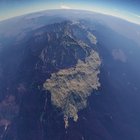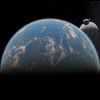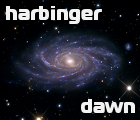|
Changing the shaders parameters
|
|
| Rodrigo | Date: Saturday, 17.03.2012, 03:17 | Message # 1 |
|
Explorer
Group: Local Moderators
 Brazil
Brazil
Messages: 285
Status: Offline
| I was trying to make more realistic canyons, so I changed the shaders files, and I got this:
before:

after:

I think it looks so much better now, because there are long rifts and valleys, just like on mars.
I´d love to have some feedback on this, especially from Spaceengineer. Please look at the code and see if I made something stupid.
this is tg_terra_height.glsl
Code
#ifdef _VERTEX_
void main()
{
gl_Position = ftransform();
gl_TexCoord[0] = gl_MultiTexCoord0;
}
#else
float HeightMapTerra(vec3 point)
{
noiseH = 0.5;
noiseLacunarity = 2.218281828459;
noiseOffset = 0.8;
float massif, global;
vec3 distort;
vec3 p = point * mainFreq + Randomize;
// Global landscape
noiseOctaves = 5;
distort = 0.35 * fBmVec3(p * 2.37);
noiseOctaves = 4;
distort += 0.005 * (1.0 - abs(fBmVec3(p * 132.3)));
global = 1.0 - Cell3Noise(p + distort);
// Venus-like structure
float venus = 0.0;
if (venusMagn > 0.05)
{
noiseOctaves = 4;
distort = fBmVec3(point * 0.3) * 1.5;
noiseOctaves = 6;
venus = fBm((point + distort) * venusFreq) * venusMagn;
}
global += venus;
global = (global - seaLevel) * 0.5 + seaLevel;
// Dunes
float dunes = 0.0;
if (dunesSqrtDensity > 0.05)
{
noiseOctaves = 3;
massif = Cell2Noise(point * 3.5 + 0.2 * fBmVec3(point*5.12));
massif = 1.0 - smoothstep(0.0, 1.0, massif / dunesSqrtDensity);
if (massif > 0.0)
{
noiseOctaves = 5.0;
dunes = dunesFreq + fBm(p * 3.21);
dunes = max(fBm(p * dunes) + 0.7, 0.0);
dunes = dunesMagn * massif * dunes;
}
}
// "Eroded" hills
float hills = 0.0;
if (hillsSqrtDensity > 0.05)
{
noiseOctaves = 3;
massif = Cell2Noise(point * 4.0 + 0.2 * fBmVec3(point*5.12));
massif = 1.0 - smoothstep(0.0, 1.0, massif / hillsSqrtDensity);
if (massif > 0.0)
{
noiseOctaves = 10.0;
noiseH = 1.0;
noiseOffset = 1.0;
hills = hillsMagn * massif * (1.5 - RidgedMultifractal(point * hillsFreq + Randomize, 2.0));
//noiseOctaves = 10.0;
//distort = 0.2 * fBmVec3(p * 15.2);
//vec2 cell = Cell3Noise2(25.51 * (p + distort));
//hills = smoothstep(0.0, 1.0, abs(cell.y - cell.x));
}
}
// Canyons
float canyon = 0.0;
if (canyonSqrtDensity > 0.05)
{
noiseOctaves = 3;
massif = Cell2Noise(point * 3.8 + 0.2 * fBmVec3(point*5.12));
massif = 1.0 - smoothstep(0.0, 1.0, massif / canyonSqrtDensity);
if (massif > 0.0)
{
noiseOctaves = 10;
canyon = 1.5 * (hillsMagn * massif * 3 * (1.5 - RidgedMultifractal(point * hillsFreq + Randomize, 2.0))) + (montesMagn * massif * 5 * RidgedMultifractal(point * montesFreq + Randomize, 2.0));
noiseH = 1.0;
noiseOffset = 1.0;
//canyonFreq + 30.0 * fBm(p * 1.321);
float canyonWidth = clamp(1.0 - 1.5 * massif, 0.3, 2.0);
canyon = pow(abs(fBm(p * 3 * canyon)), canyonWidth);
canyon = smoothstep(0.0, 1.0, (canyon - 0.5) * 6) - 1.0;
canyon = canyon * massif * canyonMagn;
}
}
global += canyon + (dunes + hills) * clamp(70 * (global - seaLevel), 0.0, 1.0);
// Mare
float mare = global;
if (mareSqrtDensity > 0.05)
{
craterDistortion = 1.0;
noiseOctaves = 6; // Mare roundness distortion
mare = MareNoise(point, global, 0.0);
}
// Craters
float crater = 0.0;
if (craterSqrtDensity > 0.05)
{
noiseOctaves = 3; // Craters roundness distortion
craterDistortion = 1.0;
craterRoundDist = 0.03;
heightFloor = -0.1;
heightPeak = 0.6;
heightRim = 1.0;
crater = CraterNoise(point, 0.5 * craterMagn, craterFreq, craterSqrtDensity, craterOctaves);
noiseOctaves = 10.0;
noiseH = 1.0;
noiseOffset = 1.0;
crater = RidgedMultifractalDetail(point * 0.3 * montesFreq + Randomize, 2.0, 0.25 * crater);
}
// Mountains
float montes = 0.0;
if (montesSqrtDensity > 0.05)
{
noiseOctaves = 3;
massif = Cell2Noise(point * 4.5 + 0.2 * fBmVec3(point*5.12));
massif = 1.0 - smoothstep(0.0, 1.0, massif / montesSqrtDensity);
//massif = saturate((global - seaLevel - 0.05) / 0.07) * 2.0 - 1.0;
//massif = 1.0 - montes*montes;
if (massif > 0.0)
{
noiseOctaves = 10.0;
noiseH = 1.0;
noiseOffset = 1.0;
montes = montesMagn * massif * RidgedMultifractal(point * montesFreq + Randomize, 2.0);
}
}
//float height = mare + crater + montes;
float height = mare + crater + montes * clamp(5 * (global - seaLevel), 0.0, 1.0);
// Assign a climate type
noiseOctaves = (cloudsStyle == 1.0) ? 5.0 : 12.0;
noiseH = 0.5;
noiseLacunarity = 2.218281828459;
noiseOffset = 0.8;
float climate, latitude;
if (tidalLock == 0.0)
{
latitude = abs(point.y);
latitude += 0.15 * (fBm(point * 0.7 + Randomize) - 1.0);
latitude = saturate(latitude);
}
else
{
latitude = 1.0 - point.x;
latitude += 0.15 * (fBm(point * 0.7 + Randomize) - 1.0);
}
// Ice caps
float edge;
if (cloudsStyle == 1.0)
{
edge = saturate(15.0 * (latitude - latIceCaps));
height = height * 0.1 + icecapHeight * edge;
}
else
{
edge = saturate(3.0 * (latitude - latIceCaps));
height += icecapHeight * sqrt(edge);
}
return height;
}
void main()
{
vec3 point = GetSurfacePoint();
//float height = max((HeightMapTerra(point) - seaLevel) / (1.0 + montesMagn), 0.0);
float height = HeightMapTerra(point);
gl_FragColor = vec4(height);
}
#endif
|
| |
| |
| Rodrigo | Date: Saturday, 17.03.2012, 03:28 | Message # 2 |
|
Explorer
Group: Local Moderators
 Brazil
Brazil
Messages: 285
Status: Offline
| hmm.... I was flying around some places, and I guess thre´s too much noise. I´ll try to soften it.
|
| |
| |
| Rodrigo | Date: Saturday, 17.03.2012, 03:52 | Message # 3 |
|
Explorer
Group: Local Moderators
 Brazil
Brazil
Messages: 285
Status: Offline
| I dunno, maybe this is a little better:

Code
#ifdef _VERTEX_
void main()
{
gl_Position = ftransform();
gl_TexCoord[0] = gl_MultiTexCoord0;
}
#else
float HeightMapTerra(vec3 point)
{
noiseH = 0.5;
noiseLacunarity = 2.218281828459;
noiseOffset = 0.8;
float massif, global;
vec3 distort;
vec3 p = point * mainFreq + Randomize;
// Global landscape
noiseOctaves = 5;
distort = 0.35 * fBmVec3(p * 2.37);
noiseOctaves = 4;
distort += 0.005 * (1.0 - abs(fBmVec3(p * 132.3)));
global = 1.0 - Cell3Noise(p + distort);
// Venus-like structure
float venus = 0.0;
if (venusMagn > 0.05)
{
noiseOctaves = 4;
distort = fBmVec3(point * 0.3) * 1.5;
noiseOctaves = 6;
venus = fBm((point + distort) * venusFreq) * venusMagn;
}
global += venus;
global = (global - seaLevel) * 0.5 + seaLevel;
// Dunes
float dunes = 0.0;
if (dunesSqrtDensity > 0.05)
{
noiseOctaves = 3;
massif = Cell2Noise(point * 3.5 + 0.2 * fBmVec3(point*5.12));
massif = 1.0 - smoothstep(0.0, 1.0, massif / dunesSqrtDensity);
if (massif > 0.0)
{
noiseOctaves = 5.0;
dunes = dunesFreq + fBm(p * 3.21);
dunes = max(fBm(p * dunes) + 0.7, 0.0);
dunes = dunesMagn * massif * dunes;
}
}
// "Eroded" hills
float hills = 0.0;
if (hillsSqrtDensity > 0.05)
{
noiseOctaves = 3;
massif = Cell2Noise(point * 4.0 + 0.2 * fBmVec3(point*5.12));
massif = 1.0 - smoothstep(0.0, 1.0, massif / hillsSqrtDensity);
if (massif > 0.0)
{
noiseOctaves = 10.0;
noiseH = 1.0;
noiseOffset = 1.0;
hills = hillsMagn * massif * (1.5 - RidgedMultifractal(point * hillsFreq + Randomize, 2.0));
//noiseOctaves = 10.0;
//distort = 0.2 * fBmVec3(p * 15.2);
//vec2 cell = Cell3Noise2(25.51 * (p + distort));
//hills = smoothstep(0.0, 1.0, abs(cell.y - cell.x));
}
}
// Canyons
float canyon = 0.0;
if (canyonSqrtDensity > 0.05)
{
noiseOctaves = 3;
massif = Cell2Noise(point * 3.8 + 0.2 * fBmVec3(point*5.12));
massif = 1.0 - smoothstep(0.0, 1.0, massif / canyonSqrtDensity);
if (massif > 0.0)
{
noiseOctaves = 10;
canyon = 1.8 * (hillsMagn * massif * 3 * (1.5 - RidgedMultifractal(point * hillsFreq + Randomize, 2.0))) + (montesMagn * massif * 5 * RidgedMultifractal(point * montesFreq + Randomize, 2.0));
noiseH = 1.5;
noiseOffset = 1.0;
//canyonFreq + 30.0 * fBm(p * 1.321);
float canyonWidth = clamp(1.0 - 1.5 * massif, 0.3, 2.0);
canyon = pow(abs(fBm(p * 3 * canyon)), canyonWidth);
canyon = smoothstep(0.0, 1.0, (canyon - 0.5) * 6) - 1.0;
canyon = canyon * massif * canyonMagn;
}
}
global += canyon + (dunes + hills) * clamp(70 * (global - seaLevel), 0.0, 1.0);
// Mare
float mare = global;
if (mareSqrtDensity > 0.05)
{
craterDistortion = 1.0;
noiseOctaves = 6; // Mare roundness distortion
mare = MareNoise(point, global, 0.0);
}
// Craters
float crater = 0.0;
if (craterSqrtDensity > 0.05)
{
noiseOctaves = 3; // Craters roundness distortion
craterDistortion = 1.0;
craterRoundDist = 0.03;
heightFloor = -0.1;
heightPeak = 0.6;
heightRim = 1.0;
crater = CraterNoise(point, 0.5 * craterMagn, craterFreq, craterSqrtDensity, craterOctaves);
noiseOctaves = 10.0;
noiseH = 1.0;
noiseOffset = 1.0;
crater = RidgedMultifractalDetail(point * 0.3 * montesFreq + Randomize, 2.0, 0.25 * crater);
}
// Mountains
float montes = 0.0;
if (montesSqrtDensity > 0.05)
{
noiseOctaves = 3;
massif = Cell2Noise(point * 4.5 + 0.2 * fBmVec3(point*5.12));
massif = 1.0 - smoothstep(0.0, 1.0, massif / montesSqrtDensity);
//massif = saturate((global - seaLevel - 0.05) / 0.07) * 2.0 - 1.0;
//massif = 1.0 - montes*montes;
if (massif > 0.0)
{
noiseOctaves = 10.0;
noiseH = 1.0;
noiseOffset = 1.0;
montes = montesMagn * massif * RidgedMultifractal(point * montesFreq + Randomize, 2.0);
}
}
//float height = mare + crater + montes;
float height = mare + crater + montes * clamp(5 * (global - seaLevel), 0.0, 1.0);
// Assign a climate type
noiseOctaves = (cloudsStyle == 1.0) ? 5.0 : 12.0;
noiseH = 0.5;
noiseLacunarity = 2.218281828459;
noiseOffset = 0.8;
float climate, latitude;
if (tidalLock == 0.0)
{
latitude = abs(point.y);
latitude += 0.15 * (fBm(point * 0.7 + Randomize) - 1.0);
latitude = saturate(latitude);
}
else
{
latitude = 1.0 - point.x;
latitude += 0.15 * (fBm(point * 0.7 + Randomize) - 1.0);
}
// Ice caps
float edge;
if (cloudsStyle == 1.0)
{
edge = saturate(15.0 * (latitude - latIceCaps));
height = height * 0.1 + icecapHeight * edge;
}
else
{
edge = saturate(3.0 * (latitude - latIceCaps));
height += icecapHeight * sqrt(edge);
}
return height;
}
void main()
{
vec3 point = GetSurfacePoint();
//float height = max((HeightMapTerra(point) - seaLevel) / (1.0 + montesMagn), 0.0);
float height = HeightMapTerra(point);
gl_FragColor = vec4(height);
}
#endif
Edited by Rodrigo - Saturday, 17.03.2012, 06:06 |
| |
| |
| mustafa2812 | Date: Saturday, 17.03.2012, 04:33 | Message # 4 |
 Space Pilot
Group: Users
 United States
United States
Messages: 121
Status: Offline
| Those look great!
PC specs: Windows 7 64 bit. Intel Core i5-2400 quad-core (3.1GHz, 6MB Cache). 6GB DDR3-1333MGz SDRAM[2 DIMMs]. 1 TB 7200 rpm SATA 3Gb/s hard drive. 3GB DDR3 NVIDIA GeForce GT 545.
|
| |
| |
| Rodrigo | Date: Saturday, 17.03.2012, 05:29 | Message # 5 |
|
Explorer
Group: Local Moderators
 Brazil
Brazil
Messages: 285
Status: Offline
| Thanks!
Edited by Rodrigo - Saturday, 17.03.2012, 05:59 |
| |
| |
| Rodrigo | Date: Saturday, 17.03.2012, 19:59 | Message # 6 |
|
Explorer
Group: Local Moderators
 Brazil
Brazil
Messages: 285
Status: Offline
| Did anyone else try this?
|
| |
| |
| Duke | Date: Saturday, 17.03.2012, 21:37 | Message # 7 |
|
Space Pilot
Group: SE team
 Antarctica
Antarctica
Messages: 88
Status: Offline
| I've tried. looks good.
Edited by Duke - Saturday, 17.03.2012, 21:42 |
| |
| |
| Freak2121 | Date: Sunday, 18.03.2012, 03:16 | Message # 8 |
 Space Pilot
Group: Users
 Canada
Canada
Messages: 89
Status: Offline
| These are pretty good.

I messed with clouds a bit, right now I'm using this:
Code #ifdef _VERTEX_
void main()
{
gl_Position = ftransform();
gl_TexCoord[0] = gl_MultiTexCoord0;
}
#else
float HeightMapClouds(vec3 point)
{
//return 0.0;
float zone = cos(point.y);
float ang = zone * twistMagn;
float weight = 1.0;
float offset = 0.0;
vec3 twistedPoint = point;
// Compute cyclons
vec3 cycloneCenter;
float cycloneRadius = 1.0;
float cycloneAmpl;
if (tidalLock != 0.0)
{
cycloneCenter = vec3(0.0, 1.0, 0.0);
cycloneRadius = length(cycloneCenter - point) / cycloneSqrtDensity;
cycloneAmpl = -cycloneMagn * sign(cycloneCenter.y);
}
else
{
vec4 cell = Cell2NoiseVec(point * cycloneFreq);
cycloneCenter = cell.xyz;
cycloneRadius = length(cycloneCenter - point) / cycloneSqrtDensity;
cycloneAmpl = 0.8*pi * sign(cycloneCenter.y);
}
if (cycloneRadius < 1.0)
{
float dist = 1.0 - cycloneRadius;
float fi = mix(log(cycloneRadius), pow(dist, 3.0), cycloneRadius);
twistedPoint = Rotate(cycloneAmpl*fi, cycloneCenter, point);
if (cycloneRadius < 0.05)
weight = 1.0 - pow(1.0 - cycloneRadius / 0.05, 2);
else
weight = 1.0;
weight = weight * (1.0 + dist);
//offset += 0.7 * dist;
}
// Compute Coriolis effect
float sina = sin(ang);
float cosa = cos(ang);
twistedPoint = vec3(cosa*twistedPoint.x-sina*twistedPoint.z, twistedPoint.y, sina*twistedPoint.x+cosa*twistedPoint.z);
twistedPoint = twistedPoint * cloudsFreq + Randomize;
// Compute flow-like distortion
noiseH = 0.75;
noiseLacunarity = 5.5;
noiseOffset = 0.8;
noiseOctaves = 4;
vec3 distort = fBmVec3(twistedPoint * 0.75) * 1.5;
noiseOctaves = 6;
float global = (fBm(twistedPoint + distort) + 1.0) * 0.7;
global = (global + offset) * weight;
// Compute turbilence features
noiseOctaves = cloudsOctaves;
float turbulence = fBm(point * 100.0 * cloudsFreq + Randomize) * 0.1;
return global + turbulence * step(0.1, global);
}
void main()
{
vec3 point = GetSurfacePoint();
float height = HeightMapClouds(point);
gl_FragColor = vec4(height);
}
#endif
Don't know if it's any better or not, but I definitely think we should work together to improve clouds. They're a bit lacking right now.
Intel Core i5 @ 4.534GHz
8GBs of DDR3 RAM @ 1600mhz
EVGA GTX970 SSC
Windows 7 64-bit
|
| |
| |
| SpaceEngineer | Date: Sunday, 18.03.2012, 14:14 | Message # 9 |
 Author of Space Engine
Group: Administrators
 Russian Federation
Russian Federation
Messages: 4800
Status: Offline
| Please mark your changes in commets, I don't want to simply replace my shaders, but to look at your changes.
*

|
| |
| |
| Rodrigo | Date: Monday, 19.03.2012, 12:12 | Message # 10 |
|
Explorer
Group: Local Moderators
 Brazil
Brazil
Messages: 285
Status: Offline
| Ok
I changed this line of code on //canyons
"
>>> noiseOctaves = 10;
>>> canyon = 1.8 * (hillsMagn * massif * 3 * (1.5 - RidgedMultifractal(point * hillsFreq + Randomize, 2.0))) + (montesMagn * massif * 5 * RidgedMultifractal(point * montesFreq + Randomize, 2.0));
>>> noiseH = 1.5;
>>> noiseOffset = 1.0;
//canyonFreq + 30.0 * fBm(p * 1.321);
float canyonWidth = clamp(1.0 - 1.5 * massif, 0.3, 2.0);
>>> canyon = pow(abs(fBm(p * 3 * canyon)), canyonWidth);
canyon = smoothstep(0.0, 1.0, (canyon - 0.5) * 6) - 1.0;
canyon = canyon * massif * canyonMagn;
}
}
"
As gou see, i mixed some parameters from mountains & eroded hills, and made some random changes until it looked good! It looks now that there's some erosion effect from water or any liquid.
Ps: i am no programmer, that's why I asked to you to see if I made something stupid with your code. 
|
| |
| |
| Rodrigo | Date: Tuesday, 20.03.2012, 02:36 | Message # 11 |
|
Explorer
Group: Local Moderators
 Brazil
Brazil
Messages: 285
Status: Offline
| Double post
Edited by Rodrigo - Tuesday, 20.03.2012, 02:55 |
| |
| |
| SpaceEngineer | Date: Wednesday, 21.03.2012, 11:43 | Message # 12 |
 Author of Space Engine
Group: Administrators
 Russian Federation
Russian Federation
Messages: 4800
Status: Offline
| Hmmm, I can implement supporting of custom shaders for user-made planets. I.e. you can make a planetary system, assigning your textures for planets, and to write your own shaders for it. But these shaders will work only on your planets, the rest of the Universe will be unchanged.
*

|
| |
| |
| HarbingerDawn | Date: Wednesday, 21.03.2012, 19:15 | Message # 13 |
 Cosmic Curator
Group: Administrators
 United States
United States
Messages: 8717
Status: Offline
| Quote (SpaceEngineer) Hmmm, I can implement supporting of custom shaders for user-made planets. I.e. you can make a planetary system, assigning your textures for planets, and to write your own shaders for it. But these shaders will work only on your planets, the rest of the Universe will be unchanged.
This is a great idea. It would give people the freedom to experiment, express their ideas and make their own visions come to life, while maintaining a consistent procedural universe for all users.
All forum users, please read this!
My SE mods and addons
Phenom II X6 1090T 3.2 GHz, 16 GB DDR3 RAM, GTX 970 3584 MB VRAM
|
| |
| |